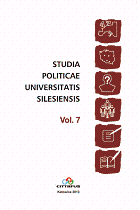Development of Local Government in Central and Eastern European Countries
Development of Local Government in Central and Eastern European Countries
Author(s): Anna Sylwia CzyżSubject(s): Politics / Political Sciences
Published by: Wydawnictwo Uniwersytetu Śląskiego
Keywords: government reform; local government structure; fall of communism; political changes; democracy; decentralization
Summary/Abstract: One of the most important elements of the political and democratic transformation after 1989 in Central and Eastern European countries was local government reform. The main aim of the reform was to renew the local government structure and replace the Soviet system of councils which had a highly centralized administrative and bureaucratic structure. The introduction of local self-government was considered as an essential task in the process of political change after the fall of communism. The basic regulations of the local government system were included in the constitutions, acts on local government, and acts on free local elections adopted in ten Central and Eastern European countries which became members of the European Union in 2004 (Czech Republic, Estonia, Latvia, Lithuania, Poland, Slovakia, Slovenia and Hungary) and in 2007 (Bulgaria and Romania). The main principles of local government reform in CEE countries included: – democratization and decentralization, – autonomy from the central government, – establishment of independent local budgets, – property transformation, – democratic local elections.
Journal: Studia Politicae Universitatis Silesiensis
- Issue Year: 2011
- Issue No: 7 ENG
- Page Range: 65-87
- Page Count: 23
- Language: English

